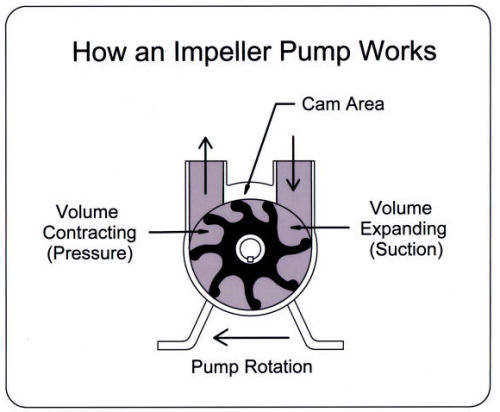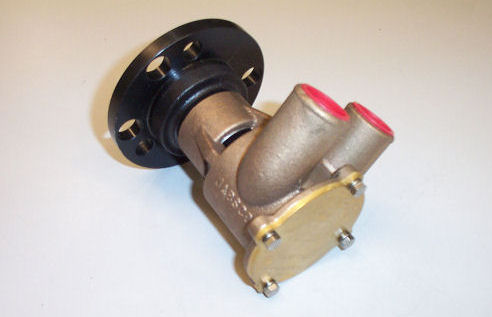Do You Have Spare Impellers?
The failure of a simple rubber impeller can spoil a planned weekend on the water. That’s why any well-equipped boat will have spares aboard. While you can’t have spares aboard for everything, you can have spares for a few of the most likely items to fail and impellers are high on the list. You might have as many as seven or more of them here and there on your boat.

Courtesy of Virtualboatyard.com--
Ever stop to think how dependent your boat is on a little rubber impeller? Or how many of them you have aboard? Depending on the size of your boat, it could be from one to as many as seven or more. They reside in the outdrive, electric head, pressurized water system, wash-down pump and oil-change system, engine cooling-water pump, and fuel pump for example. Failure of any of them could result in consequences that range from a smelly mess, a delayed vacation, to a possible sinking or expensive damage to your engine and drive train.

Pump Maintenance
Some manufacturers recommend replacing the impeller every year. Some OEMs recommend removing the impeller from its housing during winter lay-up. Most of us don’t do either.
Impeller pumps generally fail in one of two ways. The first is a gradual degradation in pump performance and flow. This is usually due to impeller or housing wear or impeller age.
The second failure mode is a sudden, catastrophic failure, with the impeller usually losing some or all of its blades. This is usually caused by running the impeller pump dry. Remember, the fluid being pumped provides the cooling and lubrication for the pump. This is often caused by a water inlet seacock not being opened or a plastic bag covering the water inlet.
The impeller often sheds its blades in such a failure. The errant blades must be tracked down and removed from the system, especially if it is an engine cooling application. Failing to do so will usually lead to further problems and blockages later on.

Outboard Motor Pumps…
Outboard engine pumps are probably the most difficult to maintain. Changing the impeller requires separating the lower gear case from the engine. This also may require disconnecting the shift linkage. Consult your engine manual for the specific steps required the get to the pump.
When the lower unit is free, the pump will usually be located on top of the gear case. The housing can then be unbolted and the impeller replaced. Carefully inspect the housing and the stamped steel liner for signs of wear or overheating. Rebuild kits are available that range from just the impeller and gasket, to kits that include upper and lower housing as well as the wear plate. If in doubt, replace. You don’t want to have to drop the gear case any more than necessary.
Engine-Cooling Pumps…
Most engine-cooling pumps have a cover plate held on with several bolts. Removing the screws and cover plate exposes the impeller. If the impeller has been changed regularly, it should just slide off the shaft. In many cases, it will need to be pried out with a couple of screwdrivers. Take great care not to damage the housing, these can be expensive to replace.

Many manufacturers make impeller puller, much like gear puller, for extreme cases but they are pricey. Some manufacturers have threaded the inside of the exposed end of the impeller. Removing this type of impeller is a simple matter of threading the right size bolt in the open end. As the bolt is tightened, it bears on the pump shaft and backs the impeller out. More manufacturers should consider this design feature.
Freestanding impeller pumps are usually easy to disassemble and service, if the pump itself is accessible. A hint when servicing a macerator pump: place plenty of adult diapers around and under the pump to soak up any “stuff” that may dribble out of the pump.
Do Your Homework First…
Before boaters decide to perform maintenance on the impeller pump, they should take a few preliminary steps. They should make sure to identify the exact pump they have and have the appropriate rebuild kits or replacement impellers on hand. There are several pump and impeller manufacturers and many make interchangeable impellers. Have all those numbers available when shopping for spare parts. The store may carry only one brand or the other (Every boater DOES document those numbers in their onboard maintenance manual, right?).

Make sure the right tools are available. Do a dry run to make sure the tools fit the jib. Special wrenches or short screwdrivers might be required. Trying to replace an impeller at night on a rolling sea isn’t the time to develop your repair strategy.
Conclusion
Impeller pump maintenance isn’t rocket science and is well within most boat owner’s capabilities. Make sure to have the parts and tools before starting and don’t be afraid to look at the service manual or rebuild kit directions.
--Capt’n Pauley, Virtualboatyard.com